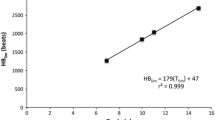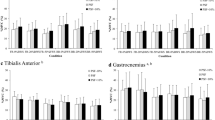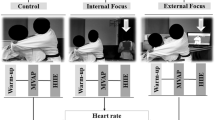Abstract
Purpose
The purpose of this study was to explore relationships between attentional strategies and LRC, running economy, perceived exertion, and dyspnea.
Methods
25 endurance-trained males (\( \dot{\text V}\)O2max = 68.2 ± 4.7 mL kg−1 min−1) ran for 5 min each at two different submaximal speeds, during which LRC and oxygen consumption (\( \dot{\text V}\)O2) were measured. The degree of LRC was calculated as the percentage of breaths occurring during the same decile of the step cycle. Attentional focus was assessed at the end of exercise using an Attentional Focusing Questionnaire, with subscales for association, dissociation, and distress.
Results
We found no significant relationships between attentional focus measures and LRC. However, dissociation scores were positively correlated with \( \dot{\text V}\)O2 (r = 0.404), as well as %\( \dot{\text V}\)O2max (r = 0.474), at the slower running speed. Distress scores were the only attentional focus subscale related to perceived exertion and dyspnea (r = 0.378 to 0.654).
Conclusion
These findings suggest attentional focus is not driving the high levels of LRC seen in trained endurance athletes but may relate to running economy and perceptual responses.



Similar content being viewed by others
Availability of data and material
The data that support the findings of this study are available on request from the corresponding author, AS. The data are not publicly available due to their containing information that could compromise the privacy of research participants.
Abbreviations
- AFQ:
-
Attentional Focusing Questionnaire
- CI:
-
Confidence interval
- DYS:
-
Ratings of dyspnea
- LRC:
-
Locomotor–respiratory coupling
- RE:
-
Running economy
- RPE:
-
Ratings of perceived exertion
- \( \dot{\text V}\) E :
-
Minute ventilation
- \( \dot{\text V}\)O2 :
-
Oxygen consumption
- \( \dot{\text V}\)O2max :
-
Maximal oxygen consumption
References
Baden DA, McLean TL, Tucker R, Noakes TD, Gibson AS (2005) Effect of anticipation during unknown or unexpected exercise duration on rating of perceived exertion, affect, and physiological function. Br J Sport Med 39:742–746. https://doi.org/10.1136/bjsm.2004.016980
Barwood MJ, Thelwell RC, Tipton MJ (2008) Psychological skills training improves exercise performance in the heat. Med Sci Sports Exerc 40:387–396. https://doi.org/10.1249/mss.0b013e31815adf31
Bernasconi P, Kohl J (1993) Analysis of co-ordination between breathing and exercise rhythms in man. J Physiol 471:693–706
Bramble DM, Carrier DR (1983) Running and breathing in mammals. Science 219:251–256
Brewer BW, Van Raalte JL, Linder DE (1996) Attentional focus and endurance performance. Appl Res Coach Athlet Ann 11:1–14
Brick N, MacIntyre T, Campbell M (2014) Attentional focus in endurance activity: new paradigms and future directions. Int Rev Sport Exerc Psychol 7:103–134
Connolly CT, Janelle CM (2003) Attentional strategies in rowing: performance, perceived exertion, and gender considerations. J Appl Sport Psychol 15:195–212
Daffertshofer A, Huys R, Beek PJ (2004) Dynamical coupling between locomotion and respiration. Biol Cybern 90:157–164. https://doi.org/10.1007/s00422-004-0462-x
Di Prampero PE, Capelli C, Pagliaro P, Antonutto G, Girardis M, Zamparo P, Soule RG (1993) Energetics of best performances in middle-distance running. J Appl Physiol 74:2318–2324. https://doi.org/10.1152/jappl.1993.74.5.2318
Fallowfield J, Wilkinson D (1995) Improving sports performance in middle and long distance running: a scientific approach to race preparation. Wiley, New York
Foster C, Lucia A (2007) Running economy: the forgotten factor in elite performance. Sports Med 37:316–319. https://doi.org/10.2165/00007256-200737040-00011
Fulton TJ, Paris HL, Stickford ASL, Gruber AH, Mickleborough TD (1985) Chapman RF (2018) Locomotor-respiratory coupling is maintained in simulated moderate altitude in trained distance runners. J Appl Physiol 125:1–7. https://doi.org/10.1152/japplphysiol.01122.2017
Gabana N, Van Raalte JL, Hutchinson J, Brewer B, Petitpas AJ (2014) The effects of music and a coxswain on attentional focus, perceived exertion, motivation, and performance during a 1000 m ergometer rowing sprint. J Appl Sport Psychol 27:1–13
Garlando F, Kohl J, Koller EA, Pietsch P (1985) Effect of coupling the breathing- and cycling rhythms on oxygen uptake during bicycle ergometry. Eur J Appl Physiol Occup Physiol 54:497–501
Hoffmann CP, Torregrosa G, Bardy BG (2012) Sound stabilizes locomotor-respiratory coupling and reduces energy cost. PLoS ONE 7:e45206. https://doi.org/10.1371/journal.pone.0045206
Hopker J, Coleman D, Passfield L (2009) Changes in cycling efficiency during a competitive season. Med Sci Sports Exerc 41:912–919. https://doi.org/10.1249/MSS.0b013e31818f2ab2
Hunter I, Smith GA (2007) Preferred and optimal stride frequency, stiffness and economy: changes with fatigue during a 1-h high-intensity run. Eur J Appl Physiol 100:653–661. https://doi.org/10.1007/s00421-007-0456-1
Johnson BD, Saupe KW (1985) Dempsey JA (1992) Mechanical constraints on exercise hyperpnea in endurance athletes. J Appl Physiol 73:874–886. https://doi.org/10.1152/jappl.1992.73.3.874
Mahler DA, Hunter B, Lentine T, Ward J (1991) Locomotor-respiratory coupling develops in novice female rowers with training. Med Sci Sports Exerc 23:1362–1366
Marchant DC, Greig M, Bullough J, Hitchen D (2011) Instructions to adopt an external focus enhance muscular endurance. Res Q Exerc Sport 82:466–473. https://doi.org/10.1080/02701367.2011.10599779
Masters KS, Lambert MJ (1989) The relations between cognitive coping strategies. Reasons for running, injury, and performance of marathon runners. J Sport Exercise Psychol 11:161–170. https://doi.org/10.1123/jsep.11.2.161
Masters KS, Ogles BM (1997) The relations of cognitive strategies with injury, motivation, and performance among marathon runners: results from two studies. J Appl Sport Psychol 10:281–296
Moore IS (2016) Is there an economical running technique? A review of modifiable biomechanical factors affecting running economy. Sports Med 46:793–807. https://doi.org/10.1007/s40279-016-0474-4
Morgan WP, Pollock ML (1977) Psychologic characterization of the elite distance runner. Ann N Y Acad Sci 301:382–403
Morgan WP, Horstman DH, Cymerman A, Stokes J (1983) Facilitation of physical performance by means of a cognitive strategy. Cogn Ther Res 7:251–264. https://doi.org/10.1007/Bf01205139
Neumann DL, Piercy A (2013) The effect of different attentional strategies on physiological and psychological states during running. Aust Psychol 48:329–337
O’Halloran J, Hamill J, McDermott WJ, Remelius JG, Van Emmerik RE (2012) Locomotor-respiratory coupling patterns and oxygen consumption during walking above and below preferred stride frequency. Eur J Appl Physiol 112:929–940. https://doi.org/10.1007/s00421-011-2040-y
Otis AB, Fenn WO, Rahn H (1950) Mechanics of breathing in man. J Appl Physiol 2:592–607. https://doi.org/10.1152/jappl.1950.2.11.592
Rassler B, Kohl J (1996) Analysis of coordination between breathing and walking rhythms in humans. Respir Physiol 106:317–327
Schucker L, Parrington L (2019) Thinking about your running movement makes you less efficient: attentional focus effects on running economy and kinematics. J Sports Sci 37:638–646. https://doi.org/10.1080/02640414.2018.1522697
Schucker L, Hagemann N, Strauss B, Volker K (2009) The effect of attentional focus on running economy. J Sports Sci 27:1241–1248. https://doi.org/10.1080/02640410903150467
Schucker L, Knopf C, Strauss B, Hagemann N (2014) An internal focus of attention is not always as bad as its reputation: how specific aspects of internally focused attention do not hinder running efficiency. J Sport Exerc Psychol 36:233–243. https://doi.org/10.1123/jsep.2013-0200
Sherman MF, Lam T, Sheel AW (2009) Locomotor-respiratory synchronization after body weight supported treadmill training in incomplete tetraplegia: a case report. Spinal Cord 47:896–898. https://doi.org/10.1038/sc.2009.50
Stevinson CD, Biddle SJH (1999) Cognitive strategies in running: a response to masters and ogles. Sport Psychol 13:235–236
Stickford ASL, Stickford JL (2014) Ventilation and locomotion in humans: mechanisms, implications, and perturbations to the coupling of these two rhythms. Springer Sci Rev 2:95–118
Stickford AS, Stickford JL, Tanner DA, Stager JM, Chapman RF (2015) Runners maintain locomotor-respiratory coupling following isocapnic voluntary hyperpnea to task failure. Eur J Appl Physiol 115:2395–2405. https://doi.org/10.1007/s00421-015-3220-y
Takano N, Deguchi H (1997) Sensation of breathlessness and respiratory oxygen cost during cycle exercise with and without conscious entrainment of the breathing rhythm. Eur J Appl Physiol Occup Physiol 76:209–213. https://doi.org/10.1007/s004210050238
Tammen VV (1996) Elite middle and long distance runners associative dissociative coping. Journal of Applied Sport Psychol 8:1–8. https://doi.org/10.1080/10413209608406304
van Alphen J, Duffin J (1994) Entrained breathing and oxygen consumption during treadmill walking. Can J Appl Physiol 19:432–440
Villard S, Casties JF, Mottet D (2005) Dynamic stability of locomotor respiratory coupling during cycling in humans. Neurosci Lett 383:333–338. https://doi.org/10.1016/j.neulet.2005.04.047
Williams KR, Cavanagh PR (1987) Relationship between distance running mechanics, running economy, and performance. J Appl Physiol 63:1236–1245
Womack CJ, Sieminski DJ, Katzel LI, Yataco A, Gardner AW (1997) Improved walking economy in patients with peripheral arterial occlusive disease. Med Sci Sports Exerc 29:1286–1290
Funding
This work was supported by an Indiana University School of Public Health Student Research Grant and a University Graduate School Grant-in-Aid of Doctoral Research.
Author information
Authors and Affiliations
Contributions
AS, TF, and RF conceived and designed the research. AS, JS, and TF conducted experiments. AS and JS analyzed data. AS, JS, and TL wrote the manuscript. All authors read and approved the manuscript.
Corresponding author
Ethics declarations
Conflict of interest
None declared.
Ethics approval
Protocols and procedures used in testing were approved by the local Institutional Review Board.
Consent to participate
All subjects provided written informed consent.
Consent for publication
The authors grant the publisher permission to publish the work contained herein.
Additional information
Communicated by Susan Hopkins.
Publisher's Note
Springer Nature remains neutral with regard to jurisdictional claims in published maps and institutional affiliations.
Rights and permissions
About this article
Cite this article
Stickford, A.S.L., Stickford, J.L., Fulton, T.J. et al. Attentional focus does not impact locomotor–respiratory coupling in trained runners. Eur J Appl Physiol 120, 2477–2486 (2020). https://doi.org/10.1007/s00421-020-04475-6
Received:
Accepted:
Published:
Issue Date:
DOI: https://doi.org/10.1007/s00421-020-04475-6




